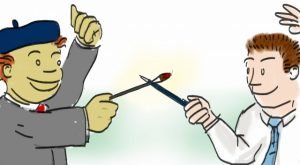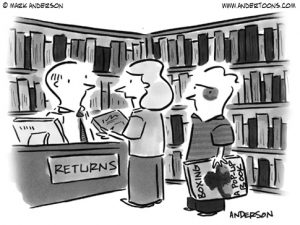There is little doubt that STEM (Science, Technology, Engineering, and Math) stands as the leading profitable and innovative force on the planet. Then, take Humanities (Art, History, Philosophy and English), a unique and diverse field of its own with perception and prose that stands unrivaled. This becomes a major point of argument, with both sides arguing legitimacy and prowess of both fields. Academic communities on both sides end up with a scenario like this:

(this is far from the actual facial expressions had by those in the two fields… but sure, let’s assume for now that it’s friendly competition).
Intellectual grenades and Marxist “landmines” are laid out in the classrooms of our schools to prove whose field is superior. Yet both sides also consider what it would be like to not have this war. Pit, no… blend the two fields together, and there lies Digital Humanities, the very pinnacle of literary theory and technology in discourse, the very Humanities and STEM majors in tandem, respectively. Would this work? If anything, this combines two completely distinct and powerful worlds, enhancing one another. But, this is by no means new; Franco Moretti’s Graphs, Maps and Trees stands as [a] precursor to Digital Humanities, by first attempting to prove that Computer Science/Computer Graphics imaging can indeed answer and map a literary genre such as the novel. Here is where I began to grow frustrated. being a former CompuSci major, I understood and practiced often how to map real-life things, a datasheet filled with thousands of earthquake geo-locations being one of them. How would something like a map, or a graph or a tree diagram prove useful to explain a village within a fictional novel, other than to organize notes in bubbles?
At this point, is where Moretti failed at his attempt to bring diagrams to English and literary theory; the book presents dozens of ideas, yet doesn’t test these ideas very well. It’s no use to spend one hundred plus pages to tell an academic discourse community to use a style that Moretti himself had not put into use. Scientific theories and quantitative analysis hold no place in humanities, something he has shown awareness of toward the end of the book. Logic would imply that Moretti was aware of the futility of taking scientific concepts to deliberately abstract a piece of text; it would destabilize (obliterate?) the mind of one already having trouble trying to organize notes on literature.
Moretti made a fine attempt at bridging the fields, but now I’m pretty sure Humanities and STEM are in this kind of crisis thanks to such a book:

Credit: Mark Anderson (andertoons.com)
I believe in Digital Humanities as our future; post-humanism and digital humanitarianism sounds lucrative and enticing in all honesty. However backing an untested idea would not be the wisest choice to make. What Moretti does exceptionally well though, is show the readers how easily humans can spot patterns, and then create an organizer to keep track of that pattern.
But this is where his genius takes a plummet (off an imaginary cliff I created just for his imaginary village, apparently). Moretti doesn’t seem to take his own hypotheses very seriously, given how quick he is to give a statement like this one:
Geography is a useful tool, yes, but does not explain everything. For that, we have astrology and ‘Theory”
It’s ideal to treat this is a justification that one system can explain a different system, but what will be created in order to explain “Theory” and Astrology? If Geography is useful yet not effective for explaining the larger picture, what is the point in arguing its properties and usage techniques? So many questions, with greater concerns (and sizable headaches) beginning to rise. HOW does one create village with properties of a spiderweb, and then say the huts in each village are not connected? I enjoyed the idea that digital concepts can be applied by theorists and students of humanities, but I took even greater pleasure disagreeing with the larger picture Moretti had in mind. His book is almost heretical in nature; he is adamant on re-imagining the way we approach literature of all levels. There are some things you just should not rush headstrong into, otherwise you will leave yourself and thousands of readers (like myself) irritated, and hilariously more confused than irritated. Organizing a book and novel using diagrams derived from a CompuSci philosophy is standard practice; we use them now unconsciously, yes. But it is still being used without the need for such a book in our possession.
Let us move forward to our more Digital Age, an era where literally all is now possible. Even blogs exist like this one, where we can share our intellectual and academic inner minds (or complaints, if splitting hairs is necessary). PowerPoints and Prezi’s are a staple for students now, signifying the true basic blend of STEM and Humanities. Science can explain how to clone a dinosaur, while humanities can offer a valuable counter-argument on why it ethically should not happen. Likewise, humanities majors can create a hypothesis and theory on the direction of our world, and scientists can explain every reason why the world is fine as is.
STEM and Humanities always go hand-in-hand, yet fight as if they were siblings and therefore refuse to acknowledge one another. It’s a childish means of explaining the strained relations, but there must be a meeting ground, one where both fields are understood. That is where our students and next generation come in, by majoring in both sciences and humanities, or may become aware enough of both to opt out and major in something entirely different. Digital Humanities is the very key, the very school which helps us create strong theories to put into practice, and it IS the common meeting ground we and the future generations need to understand the value of both academic worlds to broaden the view of the world around us.

Now that this rant is over, I think I’ll continue writing my term papers… and keeping this super special book in a shelf where the future generations may try to crack this code and alleviate the headache of this novice humanities scholar. But then, what will the future hold?
-Nicholas Santiago
©2017 AdamantRant Inc.

